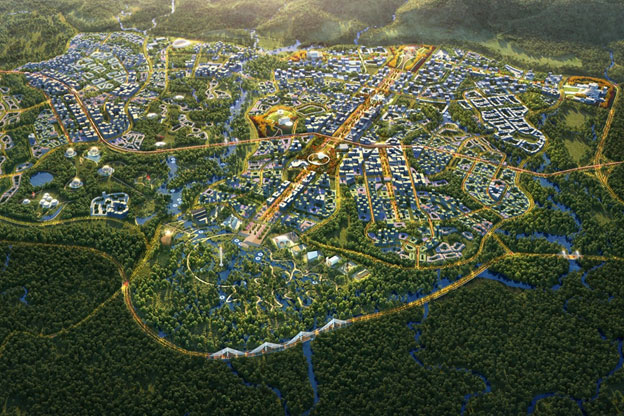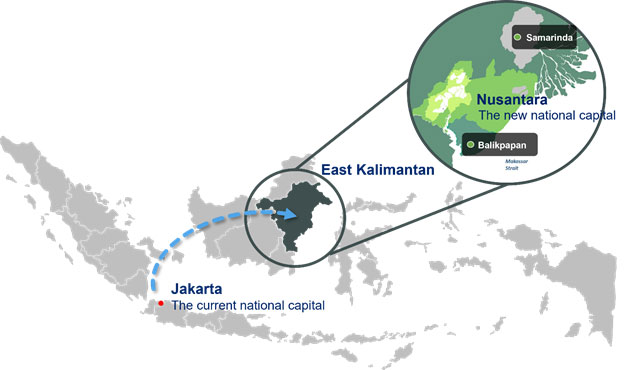Navigating Challenges of New City Development for Nusantara, Indonesias Future Capital

BANGKOK, Thailand, Sep 27 (IPS) - Many nations are engaged in ambitious urban planning endeavors and the creation of new capital cities. Nusantara, Indonesia, is the latest in a series of modern cities that have sprung up across Asia.
The government aims to create a model capital city based on the principles of liveability and green urban development on the island of Borneo.
Indonesia seeks to relocate its capital due to flooding, land subsidence, overpopulation and congestion in Jakarta, located on the island of Java, where 60 per cent of the country’s population of close to 280 million lives.
Nusantara will also play a role in rebalancing the country’s economy, and redistributing economic growth outside Java. But how can the government get such a complex endeavor right?
In this article, we explore how planners of Nusantara are leveraging a UN-supported mechanism, called the Voluntary Local Review (VLR), to promote sustainability and uphold human rights. VLRs are typically performed by authorities of existing subnational administrative areas such as provinces and cities.
Nusantara will be the first VLR for a new city ever undertaken – in order for authorities to integrate sustainability actions and key principles such as leaving no one behind already during the development stage.
Valuable lessons from other new Asian cities
- Malaysia's sustainable approach: Putrajaya, just south of Kuala Lumpur, was designed as an intelligent garden city. Its planning emphasizes green and sustainable development. Rather than separating indigenous residents from their traditional land, it incorporated existing Malay villages into the plan. The lesson here is that new capital cities should prioritize local land rights and sustainability through green infrastructure. Such initiatives contribute to a better quality of life and environmental preservation.
- Republic of Korea's phased development: Sejong City's incremental approach to its development as an administrative capital is a testament to the advantages of not rushing construction and drawing from lessons learned throughout the process. It was created to decentralize economic and political power away from Seoul. It also showcases the importance of designing new capital cities with resilience to climate change in mind, given the increasing threats of extreme weather events.
- Kazakhstan’s sustained investments: Astana's development and transformation as a capital city involved substantial investment in infrastructure, including the futuristic Norman Foster-designed Khan Shatyr Entertainment Center and the Bayterek Tower. One key lesson is that comprehensive urban planning, including spatial integration of transportation, housing, green spaces and public services, are crucial. Astana's transformation into a thriving city of 1.3 million demonstrates the importance of having a clear, long-term vision.

Seven key takeaways for Nusantara's way forward
Nusantara is learning from these examples by leveraging sustainability in its master planning and closely working with ESCAP, the UN Country Team in Indonesia and the Asian Development Bank to prepare a baseline VLR report as a tool for fostering inclusive, sustainable and rights-based development.
- Transparency and accountability: The VLR promotes transparency by providing detailed information about the progress and challenges faced in implementing the new capital. This transparency can help build trust among stakeholders, including the public, investors and government agencies. The VLR can demonstrate how the new capital's development aligns with global goals.
- Assessment of progress: The VLR can evaluate the sustainability of the new capital, including its expected environmental impact and efforts to promote sustainable practices. Nusantara aims to be a “sustainable forest city” with 25 per cent built up urban area, 65 per cent tropical forest through reforestation and 10 per cent parks and food production areas. The plan aims to conserve much of Nusantara’s tropical forest, allowing the city to be a net carbon sequestration sink before 2030 along with the goal to be a carbon neutral city by 2045.
- Data-driven decision making: By collecting and presenting data on the new capital's development in one place, the VLR can facilitate integrated data-driven decision-making. It can help policymakers identify trends and make informed choices regarding resource allocation and policy adjustments. In this process, the VLR requires municipal government departments to effectively work together and break down silos.
- Stakeholder engagement: Indigenous communities live on the site, including approximately 800 families of the Balik people. The VLR can highlight the importance of involving local communities in the planning and implementation process. It can document community feedback and demonstrate how their input has been considered and make recommendations for institutionalizing stakeholder engagement processes.
- Attracting investment: The cost estimate for Nusantara is $33 billion (Rp466 trillion), with the state budget only able to cover up to 19 per cent of the cost. Investors often look for transparent and well-documented information when considering investments. A VLR can serve as a tool to attract both domestic and international investors by showcasing the potential and progress of the new capital.
- International collaboration: Sharing a VLR report with international organizations and other countries can open avenues for benchmarking, collaboration and support. This can include financial aid, technical assistance, and knowledge exchange.
- Risk mitigation: Identifying risks and challenges in the VLR allows for proactive mitigation strategies. This can help prevent delays and cost overruns in the development process.
While significant attention is focused on Nusantara, it’s clear that relocating administrative functions may not address all social and environmental problems in Jakarta, especially for those most vulnerable.
The development of Nusantara has the potential to help Jakarta address its longstanding problems by relieving population pressure, improving infrastructure and setting an example for sustainable urban development. However, the success of this endeavor will depend on careful planning, infrastructure investment, and effective governance.
Omar Sidique is Economic Affairs Officer, UN Economic and Social Commissions for Asia and the Pacific; Diani Sadiawati is Special Staff to the Head, Nusantara Capital City Authority, Government of Indonesia; and Diandra Pratami is Development Coordination Officer, UN Resident Coordinator’s Office, Indonesia
IPS UN Bureau
Follow @IPSNewsUNBureau
Follow IPS News UN Bureau on Instagram
© Inter Press Service (2023) — All Rights Reserved. Original source: Inter Press Service
 Global Issues
Global Issues